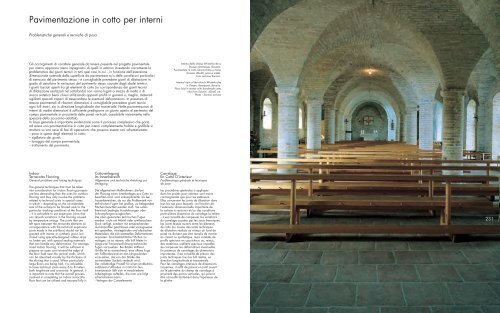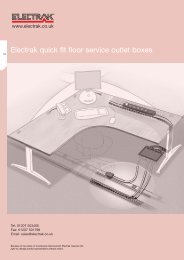by Stone & Sannini - EKA Group
by Stone & Sannini - EKA Group
by Stone & Sannini - EKA Group
Create successful ePaper yourself
Turn your PDF publications into a flip-book with our unique Google optimized e-Paper software.
Pavimentazione in cotto per interni<br />
Problematiche generali e tecniche di posa<br />
Gli accorgimenti di carattere generale da tenere presente nel progetto pavimentale<br />
per interni appaiono meno impegnativi di quelli in esterno investendo unicamente la<br />
problematica dei giunti tecnici in tutti quei casi in cui -- in funzione dell’estensione<br />
dimensionale notevole della superficie da pavimentare e/o delle condizioni particolari<br />
di esercizio del pavimento stesso -- è consigliabile prevedere giunti di dilatazione in<br />
grado di assorbire le variazioni del pavimento stesso causate dagli sbalzi termici.<br />
I giunti lasciati aperti fra gli elementi di cotto (in corrispondenza dei giunti tecnici<br />
di dilatazione realizzati nel sottofondo) non vanno fugati a mezzo di malta o di<br />
stucco sintetico bensì chiusi utilizzando appositi profili in gomma o, meglio, materiali<br />
sigillanti speciali capaci di assecondare le eventuali deformazioni. In presenza di<br />
stesure pavimentali di rilevanti dimensioni è consigliabile prevedere giunti tecnici<br />
ogni 6-8 metri, sia in direzione longitudinale che trasversale. Nelle pavimentazioni di<br />
interni di medie dimensioni è sufficiente predisporre un giunto aperto al perimetro del<br />
campo pavimentale in prossimità delle pareti verticali, assorbibile visivamente nello<br />
spessore dello zoccolino adottato.<br />
In linea generale è importante evidenziare come il processo complessivo che porta<br />
ad avere una pavimentazione in cotto per interni completamente fruibile e godibile si<br />
struttura su una serie di fasi di operazioni che possono essere così schematizzate:<br />
-- posa in opera degli elementi in cotto;<br />
-- sigillatura dei giunti;<br />
-- lavaggio del campo pavimentale;<br />
-- trattamento del pavimento.<br />
Indoor<br />
Terracotta Flooring<br />
General problems and laying techniques<br />
The general techniques that must be taken<br />
into consideration for indoor flooring projects<br />
are less demanding than the ones for outdoor<br />
flooring and they only involve the problems<br />
related to technical joints in special cases<br />
in which – depending on the considerable<br />
size of the surface to be floored and/or the<br />
particular working conditions of the floor itself<br />
– it is advisable to use expansion joints that<br />
can absorb variations in the flooring caused<br />
<strong>by</strong> temperature swings. The joints that are<br />
left open between the terracotta elements (in<br />
correspondence with the technical expansion<br />
joints made in the sub-floor) should not be<br />
grouted with mortar or synthetic grout, but<br />
closed using specially-designed rubber strips<br />
or, better yet, with special sealing materials<br />
that can handle any deformation. For averagesized<br />
indoor flooring, it will be sufficient to<br />
prepare an open joint around the edge of<br />
the floor field near the vertical walls, which<br />
can be absorbed visually <strong>by</strong> the thickness of<br />
the skirting that is used. When particularly<br />
large floors are being laid, it is advisable<br />
to have technical joints every 6 to 8 meters,<br />
both lengthwise and crosswise. In general, it<br />
is important to note that the overall process<br />
involved in completing an indoor terracotta<br />
floor that can be utilised and enjoyed fully is<br />
Cottoverlegung<br />
Im Innenbereich<br />
Allgemeine und technische Anleitung zur<br />
Verlegung<br />
Die allgemeinen Maßnahmen, die bei<br />
der Planung eines Innenbelages aus Cotto zu<br />
beachten sind, sind unkomplizierter als bei<br />
Aussenbereichen, da nur die Problematik von<br />
technischen Fugen bei großen, zu belegenden<br />
Flächen beachtet werden muß. Sie sollen<br />
thermisch bedingte Ausdehnungen oder<br />
Schrumpfungen ausgleichen.<br />
Die oben genannten technischen Fugen<br />
werden nicht mit Mörtel oder synthetischem<br />
Stuck verfugt, sondern mit entsprechenden<br />
Gummiprofilen geschlossen oder vorzugsweise<br />
mit speziellen, versiegelnden und elastischen<br />
Materialien, die sich eventuellen Deformationen<br />
anpassen. Sind beträchtliche Flächen zu<br />
verlegen, ist es ratsam, alle 6-8 Meter in<br />
Längs-und Transversalrichtung technische<br />
Fugen vorzusehen. Bei Böden mittlerer<br />
Größe ist es ausreichend, eine offene Fuge<br />
am Fußbodenrand an den Längswänden<br />
vorzusehen, die von der Stärke des<br />
verwendeten Sockels verdeckt wird.<br />
Der vollständige Prozeß für einen problemlos<br />
nutzbaren Fußboden in Cotto für den<br />
Innenbereich läßt sich in verschiedene<br />
Arbeitsgänge aufteilen, die man wie folgt<br />
schematisieren kann:<br />
- Verlegen der Cottoelemente<br />
Interno della chiesa WinterKirche a<br />
Diessen Ammersee, Baviera,<br />
Pavimentata in cotto <strong>Sannini</strong> fatto a mano<br />
classico 40x40, posa a malta.<br />
Foto archivio <strong>Sannini</strong>.<br />
Internal view of the church Winterkirche<br />
in Diesen, Ammersee, Bavaria.<br />
Floor laid in mortar with handmade cotto<br />
tiles from <strong>Sannini</strong>, 40x40 cm.<br />
Photo : <strong>Sannini</strong> archive<br />
Carrelage<br />
En Cotto D’interieur<br />
Problèmatique générale et tecniques<br />
de pose<br />
Les procédures générales à appliquer<br />
dans les projets pour intérieur sont moins<br />
contraignantes que pour les extérieurs.<br />
Elles concernent les joints de dilatation dans<br />
tous les cas pour lesquels - en fonction de<br />
l’extension dimensionnelle importante de<br />
la surface à recouvrir et/ou des conditions<br />
particulières d’exercice du carrelage lui-même<br />
-- il est conseillé de compenser les variations<br />
du carrelage causées par les sauts thermiques.<br />
Les joints laissés ouverts entre les éléments<br />
de cotto (au niveau des joints techniques<br />
de dilatation réalisés au niveau du fond de<br />
pose) ne doivent pas être remplis de mortier<br />
au ciment ou synthétique, mais comblés de<br />
profils spéciaux en caoutchouc ou, mieux,<br />
des matériaux scellants spéciaux capables<br />
de compenser les déformations éventuelles.<br />
En présence de carrelages de dimensions<br />
importantes, il est conseillé de prévoir des<br />
joints techniques tous les 6-8 mètres, en<br />
direction longitudinale et transversale.<br />
Pour les carrelages intérieurs de dimensions<br />
moyennes, il suffit de prévoir un joint ouvert<br />
sur le périmètre du champ de carrelage à<br />
proximité des parois verticales, qui pourra<br />
être camouflé facilement dans l’épaisseur de<br />
la plinthe.<br />
231





